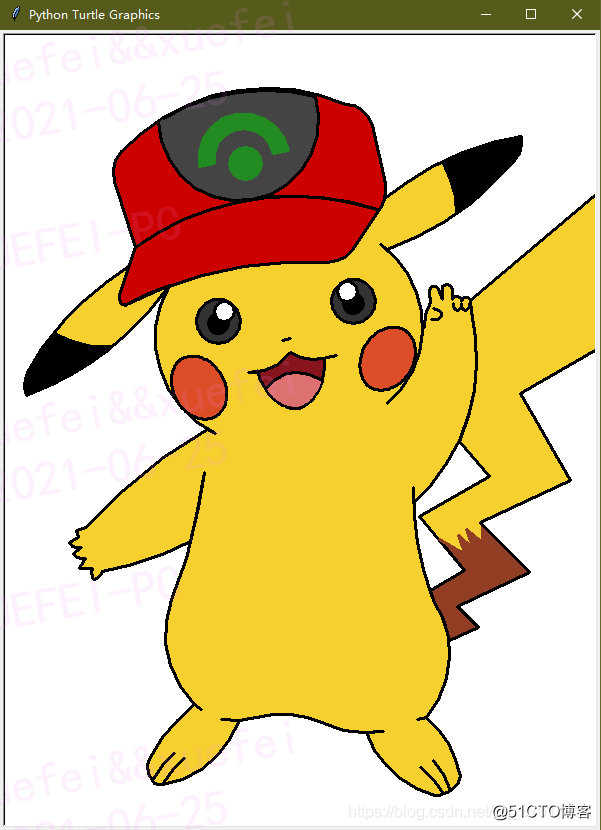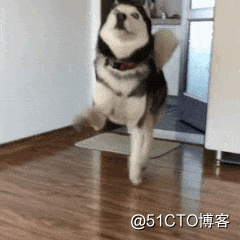用python画一只帅气的皮卡丘

没错,全网最帅的比卡丘在我这~~~

为了访问 Python 库,您需要将它导入到您的 Python 环境中,使用以下命令将其导入 turtle到您的 Python 脚本中。
import turtle
首先,让我们创建一个 Screen 实例。
wn = turtle.Screen()
现在,创建一个 Turtle 实例。
self.t = turtle.Turtle()
让我们将速度设置为 3 使用 speed 方法,这意味着皮卡丘不会只是出现在屏幕上,绘图也会有一些动画。如果您想更改背景颜色,可以使用该 bgcolor 方法,默认为白色。您可以使用pensize 方法调整笔的粗细 ,它会稍微加粗。ondrag 拖动 Turtle 将在屏幕上移动它,从而产生手绘(如果笔已放下)。
t.pensize(3) t.speed(9) t.ondrag(getPosition)
现在让我们看看这个程序中使用的一些常用方法:
Turtle(): 用于创建并返回一个新的海龟对象。
forward(value): 相对于指定的值,海龟向前移动。
向后(值): 相对于指定的值,海龟向后移动。
right(angle): 乌龟顺时针转动。
left(angle): 海龟逆时针旋转。
penup(): 捡起乌龟笔。
pendown(): 乌龟笔放下。
up(): 与 penup() 相同。
down(): 与 pendown() 相同。
color(颜色名称): Turtle 笔的颜色发生变化。
fillcolor(颜色名称): 用于填充特定形状的颜色已更改。
标题(): 返回当前标题。
position(): 返回当前位置。
goto(x, y): 将海龟的位置移动到坐标 x, y。
end_fill(): 关闭多边形后填充当前填充颜色。
begin_fill(): 记住填充多边形的起点。
dot(): 点留在当前位置。
stamp(): 海龟形状的印象留在当前位置。
Shape(): 应该是 – ‘turtle’, ‘classic’, ‘arrow’ 或 ‘circle’。
上代码:
import turtle
def getPosition(x, y):
turtle.setx(x)
turtle.sety(y)
print(x, y)
class Pikachu:
def __init__(self):
self.t = turtle.Turtle()
t = self.t
t.pensize(3)
t.speed(9)
t.ondrag(getPosition)
def noTrace_goto(self, x, y):
self.t.penup()
self.t.goto(x, y)
self.t.pendown()
def leftEye(self, x, y):
self.noTrace_goto(x, y)
t = self.t
t.seth(0)
t.fillcolor('#333333')
t.begin_fill()
t.circle(22)
t.end_fill()
self.noTrace_goto(x, y + 10)
t.fillcolor('#000000')
t.begin_fill()
t.circle(10)
t.end_fill()
self.noTrace_goto(x + 6, y + 22)
t.fillcolor('#ffffff')
t.begin_fill()
t.circle(10)
t.end_fill()
def rightEye(self, x, y):
self.noTrace_goto(x, y)
t = self.t
t.seth(0)
t.fillcolor('#333333')
t.begin_fill()
t.circle(22)
t.end_fill()
self.noTrace_goto(x, y + 10)
t.fillcolor('#000000')
t.begin_fill()
t.circle(10)
t.end_fill()
self.noTrace_goto(x - 6, y + 22)
t.fillcolor('#ffffff')
t.begin_fill()
t.circle(10)
t.end_fill()
def mouth(self, x, y):
self.noTrace_goto(x, y)
t = self.t
t.fillcolor('#88141D')
t.begin_fill()
# Lower Lip
l1 = []
l2 = []
t.seth(190)
a = 0.7
for i in range(28):
a += 0.1
t.right(3)
t.fd(a)
l1.append(t.position())
self.noTrace_goto(x, y)
t.seth(10)
a = 0.7
for i in range(28):
a += 0.1
t.left(3)
t.fd(a)
l2.append(t.position())
# Upper Lip
t.seth(10)
t.circle(50, 15)
t.left(180)
t.circle(-50, 15)
t.circle(-50, 40)
t.seth(233)
t.circle(-50, 55)
t.left(180)
t.circle(50, 12.1)
t.end_fill()
# Tongue
self.noTrace_goto(17, 54)
t.fillcolor('#DD716F')
t.begin_fill()
t.seth(145)
t.circle(40, 86)
t.penup()
for pos in reversed(l1[:20]):
t.goto(pos[0], pos[1] + 1.5)
for pos in l2[:20]:
t.goto(pos[0], pos[1] + 1.5)
t.pendown()
t.end_fill()
# Nose
self.noTrace_goto(-17, 94)
t.seth(8)
t.fd(4)
t.back(8)
# Red Cheeks
def leftCheek(self, x, y):
turtle.tracer(False)
t = self.t
self.noTrace_goto(x, y)
t.seth(300)
t.fillcolor('#DD4D28')
t.begin_fill()
a = 2.3
for i in range(120):
if 0 <= i < 30 or 60 <= i < 90:
a -= 0.05
t.lt(3)
t.fd(a)
else:
a += 0.05
t.lt(3)
t.fd(a)
t.end_fill()
turtle.tracer(True)
def rightCheek(self, x, y):
t = self.t
turtle.tracer(False)
self.noTrace_goto(x, y)
t.seth(60)
t.fillcolor('#DD4D28')
t.begin_fill()
a = 2.3
for i in range(120):
if 0 <= i < 30 or 60 <= i < 90:
a -= 0.05
t.lt(3)
t.fd(a)
else:
a += 0.05
t.lt(3)
t.fd(a)
t.end_fill()
turtle.tracer(True)
def colorLeftEar(self, x, y):
t = self.t
self.noTrace_goto(x, y)
t.fillcolor('#000000')
t.begin_fill()
t.seth(330)
t.circle(100, 35)
t.seth(219)
t.circle(-300, 19)
t.seth(110)
t.circle(-30, 50)
t.circle(-300, 10)
t.end_fill()
def colorRightEar(self, x, y):
t = self.t
self.noTrace_goto(x, y)
t.fillcolor('#000000')
t.begin_fill()
t.seth(300)
t.circle(-100, 30)
t.seth(35)
t.circle(300, 15)
t.circle(30, 50)
t.seth(190)
t.circle(300, 17)
t.end_fill()
def body(self):
t = self.t
t.fillcolor('#F6D02F')
t.begin_fill()
# Right face contour
t.penup()
t.circle(130, 40)
t.pendown()
t.circle(100, 105)
t.left(180)
t.circle(-100, 5)
# Right ear
t.seth(20)
t.circle(300, 30)
t.circle(30, 50)
t.seth(190)
t.circle(300, 36)
# Upper profile
t.seth(150)
t.circle(150, 70)
# Left ear
t.seth(200)
t.circle(300, 40)
t.circle(30, 50)
t.seth(20)
t.circle(300, 35)
#print(t.pos())
# Left face contour
t.seth(240)
t.circle(105, 95)
t.left(180)
t.circle(-105, 5)
# Left hand
t.seth(210)
t.circle(500, 18)
t.seth(200)
t.fd(10)
t.seth(280)
t.fd(7)
t.seth(210)
t.fd(10)
t.seth(300)
t.circle(10, 80)
t.seth(220)
t.fd(10)
t.seth(300)
t.circle(10, 80)
t.seth(240)
t.fd(12)
t.seth(0)
t.fd(13)
t.seth(240)
t.circle(10, 70)
t.seth(10)
t.circle(10, 70)
t.seth(10)
t.circle(300, 18)
t.seth(75)
t.circle(500, 8)
t.left(180)
t.circle(-500, 15)
t.seth(250)
t.circle(100, 65)
# Left foot
t.seth(320)
t.circle(100, 5)
t.left(180)
t.circle(-100, 5)
t.seth(220)
t.circle(200, 20)
t.circle(20, 70)
t.seth(60)
t.circle(-100, 20)
t.left(180)
t.circle(100, 20)
t.seth(300)
t.circle(10, 70)
t.seth(60)
t.circle(-100, 20)
t.left(180)
t.circle(100, 20)
t.seth(10)
t.circle(100, 60)
# Horizontal
t.seth(180)
t.circle(-100, 10)
t.left(180)
t.circle(100, 10)
t.seth(5)
t.circle(100, 10)
t.circle(-100, 40)
t.circle(100, 35)
t.left(180)
t.circle(-100, 10)
# Right foot
t.seth(290)
t.circle(100, 55)
t.circle(10, 50)
t.seth(120)
t.circle(100, 20)
t.left(180)
t.circle(-100, 20)
t.seth(0)
t.circle(10, 50)
t.seth(110)
t.circle(100, 20)
t.left(180)
t.circle(-100, 20)
t.seth(30)
t.circle(20, 50)
t.seth(100)
t.circle(100, 40)
# Right body contour
t.seth(200)
t.circle(-100, 5)
t.left(180)
t.circle(100, 5)
t.left(30)
t.circle(100, 75)
t.right(15)
t.circle(-300, 21)
t.left(180)
t.circle(300, 3)
# Right hand
t.seth(43)
t.circle(200, 60)
t.right(10)
t.fd(10)
t.circle(5, 160)
t.seth(90)
t.circle(5, 160)
t.seth(90)
t.fd(10)
t.seth(90)
t.circle(5, 180)
t.fd(10)
t.left(180)
t.left(20)
t.fd(10)
t.circle(5, 170)
t.fd(10)
t.seth(240)
t.circle(50, 30)
t.end_fill()
self.noTrace_goto(130, 125)
t.seth(-20)
t.fd(5)
t.circle(-5, 160)
t.fd(5)
# Fingers
self.noTrace_goto(166, 130)
t.seth(-90)
t.fd(3)
t.circle(-4, 180)
t.fd(3)
t.seth(-90)
t.fd(3)
t.circle(-4, 180)
t.fd(3)
# Tail
self.noTrace_goto(168, 134)
t.fillcolor('#F6D02F')
t.begin_fill()
t.seth(40)
t.fd(200)
t.seth(-80)
t.fd(150)
t.seth(210)
t.fd(150)
t.left(90)
t.fd(100)
t.right(95)
t.fd(100)
t.left(110)
t.fd(70)
t.right(110)
t.fd(80)
t.left(110)
t.fd(30)
t.right(110)
t.fd(32)
t.right(106)
t.circle(100, 25)
t.right(15)
t.circle(-300, 2)
#print(t.pos())
t.seth(30)
t.fd(40)
t.left(100)
t.fd(70)
t.right(100)
t.fd(80)
t.left(100)
t.fd(46)
t.seth(66)
t.circle(200, 38)
t.right(10)
t.fd(10)
t.end_fill()
# Tail Pattern
t.fillcolor('#923E24')
self.noTrace_goto(126.82, -156.84)
t.begin_fill()
t.seth(30)
t.fd(40)
t.left(100)
t.fd(40)
t.pencolor('#923e24')
t.seth(-30)
t.fd(30)
t.left(140)
t.fd(20)
t.right(150)
t.fd(20)
t.left(150)
t.fd(20)
t.right(150)
t.fd(20)
t.left(130)
t.fd(18)
t.pencolor('#000000')
t.seth(-45)
t.fd(67)
t.right(110)
t.fd(80)
t.left(110)
t.fd(30)
t.right(110)
t.fd(32)
t.right(106)
t.circle(100, 25)
t.right(15)
t.circle(-300, 2)
t.end_fill()
# Hat, Eye, Mouth, Cheek
self.cap(-134.07, 147.81)
self.mouth(-5, 25)
self.leftCheek(-126, 32)
self.rightCheek(107, 63)
self.colorLeftEar(-250, 100)
self.colorRightEar(140, 270)
self.leftEye(-85, 90)
self.rightEye(50, 110)
t.hideturtle()
def cap(self, x, y):
self.noTrace_goto(x, y)
t = self.t
t.fillcolor('#CD0000')
t.begin_fill()
t.seth(200)
t.circle(400, 7)
t.left(180)
t.circle(-400, 30)
t.circle(30, 60)
t.fd(50)
t.circle(30, 45)
t.fd(60)
t.left(5)
t.circle(30, 70)
t.right(20)
t.circle(200, 70)
t.circle(30, 60)
t.fd(70)
#print(t.pos())
t.right(35)
t.fd(50)
t.circle(8, 100)
t.end_fill()
self.noTrace_goto(-168.47, 185.52)
t.seth(36)
t.circle(-270, 54)
t.left(180)
t.circle(270, 27)
t.circle(-80, 98)
t.fillcolor('#444444')
t.begin_fill()
t.left(180)
t.circle(80, 197)
t.left(58)
t.circle(200, 45)
t.end_fill()
self.noTrace_goto(-58, 270)
t.pencolor('#228B22')
t.dot(35)
self.noTrace_goto(-30, 280)
t.fillcolor('#228B22')
t.begin_fill()
t.seth(100)
t.circle(30, 180)
t.seth(190)
t.fd(15)
t.seth(100)
t.circle(-45, 180)
t.right(90)
t.fd(15)
t.end_fill()
t.pencolor('#000000')
def start(self):
self.body()
def main():
print('Painting the Pikachu... ')
wn = turtle.Screen()
wn.setup(width=600, height=800)
pikachu = Pikachu()
pikachu.start()
turtle.mainloop()
if __name__ == '__main__':
main()
到此这篇关于用python画一只帅气的皮卡丘的文章就介绍到这了,更多相关python皮卡丘内容请搜索我们以前的文章或继续浏览下面的相关文章希望大家以后多多支持我们!

